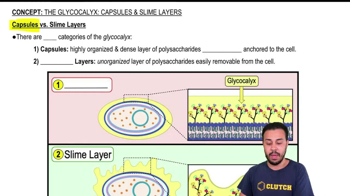Table of contents
- 1. Introduction to Biology2h 40m
- 2. Chemistry3h 40m
- 3. Water1h 26m
- 4. Biomolecules2h 23m
- 5. Cell Components2h 26m
- 6. The Membrane2h 31m
- 7. Energy and Metabolism2h 0m
- 8. Respiration2h 40m
- 9. Photosynthesis2h 49m
- 10. Cell Signaling59m
- 11. Cell Division2h 47m
- 12. Meiosis2h 0m
- 13. Mendelian Genetics4h 44m
- Introduction to Mendel's Experiments7m
- Genotype vs. Phenotype17m
- Punnett Squares13m
- Mendel's Experiments26m
- Mendel's Laws18m
- Monohybrid Crosses19m
- Test Crosses14m
- Dihybrid Crosses20m
- Punnett Square Probability26m
- Incomplete Dominance vs. Codominance20m
- Epistasis7m
- Non-Mendelian Genetics12m
- Pedigrees6m
- Autosomal Inheritance21m
- Sex-Linked Inheritance43m
- X-Inactivation9m
- 14. DNA Synthesis2h 27m
- 15. Gene Expression3h 20m
- 16. Regulation of Expression3h 31m
- Introduction to Regulation of Gene Expression13m
- Prokaryotic Gene Regulation via Operons27m
- The Lac Operon21m
- Glucose's Impact on Lac Operon25m
- The Trp Operon20m
- Review of the Lac Operon & Trp Operon11m
- Introduction to Eukaryotic Gene Regulation9m
- Eukaryotic Chromatin Modifications16m
- Eukaryotic Transcriptional Control22m
- Eukaryotic Post-Transcriptional Regulation28m
- Eukaryotic Post-Translational Regulation13m
- 17. Viruses37m
- 18. Biotechnology2h 58m
- 19. Genomics17m
- 20. Development1h 5m
- 21. Evolution3h 1m
- 22. Evolution of Populations3h 52m
- 23. Speciation1h 37m
- 24. History of Life on Earth2h 6m
- 25. Phylogeny2h 31m
- 26. Prokaryotes4h 59m
- 27. Protists1h 12m
- 28. Plants1h 22m
- 29. Fungi36m
- 30. Overview of Animals34m
- 31. Invertebrates1h 2m
- 32. Vertebrates50m
- 33. Plant Anatomy1h 3m
- 34. Vascular Plant Transport2m
- 35. Soil37m
- 36. Plant Reproduction47m
- 37. Plant Sensation and Response1h 9m
- 38. Animal Form and Function1h 19m
- 39. Digestive System10m
- 40. Circulatory System1h 57m
- 41. Immune System1h 12m
- 42. Osmoregulation and Excretion50m
- 43. Endocrine System4m
- 44. Animal Reproduction2m
- 45. Nervous System55m
- 46. Sensory Systems46m
- 47. Muscle Systems23m
- 48. Ecology3h 11m
- Introduction to Ecology20m
- Biogeography14m
- Earth's Climate Patterns50m
- Introduction to Terrestrial Biomes10m
- Terrestrial Biomes: Near Equator13m
- Terrestrial Biomes: Temperate Regions10m
- Terrestrial Biomes: Northern Regions15m
- Introduction to Aquatic Biomes27m
- Freshwater Aquatic Biomes14m
- Marine Aquatic Biomes13m
- 49. Animal Behavior28m
- 50. Population Ecology3h 41m
- Introduction to Population Ecology28m
- Population Sampling Methods23m
- Life History12m
- Population Demography17m
- Factors Limiting Population Growth14m
- Introduction to Population Growth Models22m
- Linear Population Growth6m
- Exponential Population Growth29m
- Logistic Population Growth32m
- r/K Selection10m
- The Human Population22m
- 51. Community Ecology2h 46m
- Introduction to Community Ecology2m
- Introduction to Community Interactions9m
- Community Interactions: Competition (-/-)38m
- Community Interactions: Exploitation (+/-)23m
- Community Interactions: Mutualism (+/+) & Commensalism (+/0)9m
- Community Structure35m
- Community Dynamics26m
- Geographic Impact on Communities21m
- 52. Ecosystems2h 36m
- 53. Conservation Biology24m
48. Ecology
Introduction to Ecology
Problem 3a
Textbook Question
Which of the following is characteristic of most terrestrial biomes? a. a distribution predicted almost entirely by rock and soil patterns b. clear boundaries between adjacent biomes c. vegetation demonstrating vertical layering d. cold winter months
 Verified step by step guidance
Verified step by step guidance1
Step 1: Understand the question. The question is asking which of the given options is a characteristic that most terrestrial biomes share.
Step 2: Review each option individually. Option a suggests that the distribution of biomes is predicted by rock and soil patterns. While these factors can influence the types of organisms that live in a biome, they do not solely determine the distribution of biomes.
Step 3: Consider option b, which suggests that there are clear boundaries between adjacent biomes. In reality, biomes often have transitional areas, called ecotones, where the characteristics of both biomes are present.
Step 4: Evaluate option c, which suggests that vegetation in biomes demonstrates vertical layering. This is true for many biomes, such as forests where you can see a distinct layering of vegetation from the forest floor to the canopy.
Step 5: Finally, consider option d, which suggests that all biomes have cold winter months. This is not true as some biomes, like tropical rainforests, do not have cold winter months. Therefore, the correct answer is c. vegetation demonstrating vertical layering.
 Verified video answer for a similar problem:
Verified video answer for a similar problem:This video solution was recommended by our tutors as helpful for the problem above
Video duration:
1mPlay a video:
Was this helpful?
Key Concepts
Here are the essential concepts you must grasp in order to answer the question correctly.
Terrestrial Biomes
Terrestrial biomes are large ecological areas on land characterized by specific climate conditions, flora, and fauna. They include ecosystems such as forests, deserts, grasslands, and tundras, each adapted to their unique environmental conditions. Understanding these biomes is crucial for recognizing how organisms interact with their environment and the factors that influence biodiversity.
Recommended video:
Guided course

Introduction to Terrestrial Biomes
Vegetation Vertical Layering
Vertical layering in vegetation refers to the arrangement of plant life in different heights within a biome, which can create distinct habitats. For example, in forests, there are layers such as the canopy, understory, and forest floor, each supporting different species. This concept is important for understanding how biodiversity is structured and how energy and nutrients flow through an ecosystem.
Recommended video:
Guided course

Capsules vs. Slime Layers
Biome Boundaries
Biome boundaries are the transitional zones between different biomes, often characterized by gradual changes in climate, soil, and vegetation. Unlike sharp boundaries, these transitions can be influenced by factors such as topography and human activity. Recognizing that biomes do not always have clear-cut edges helps in understanding ecological interactions and the impact of environmental changes.
Recommended video:
Guided course

Introduction to Terrestrial Biomes

 2:54m
2:54mWatch next
Master What is Ecology? with a bite sized video explanation from Jason Amores Sumpter
Start learningRelated Videos
Related Practice































































































